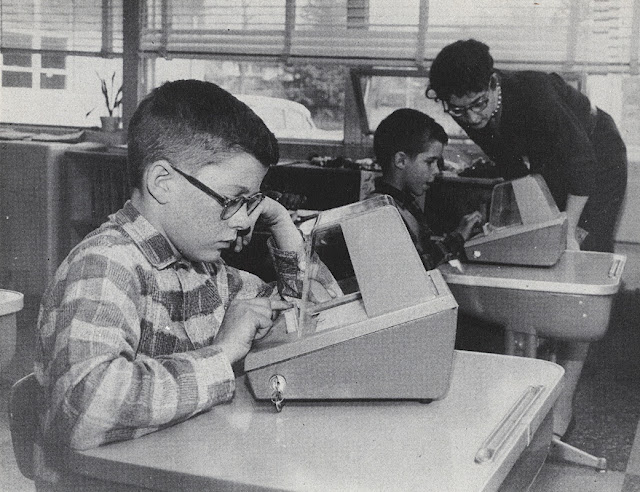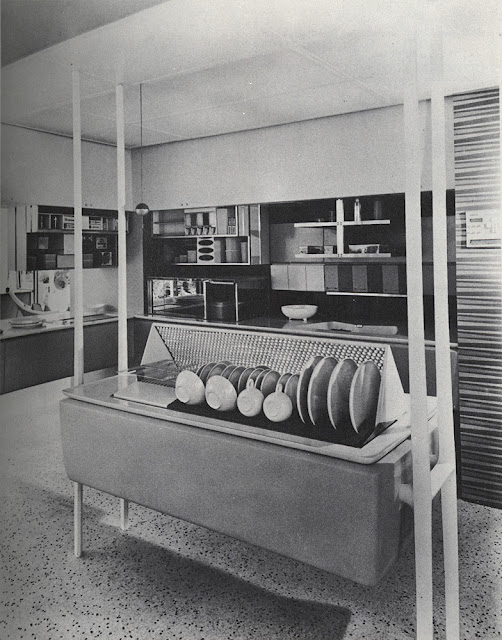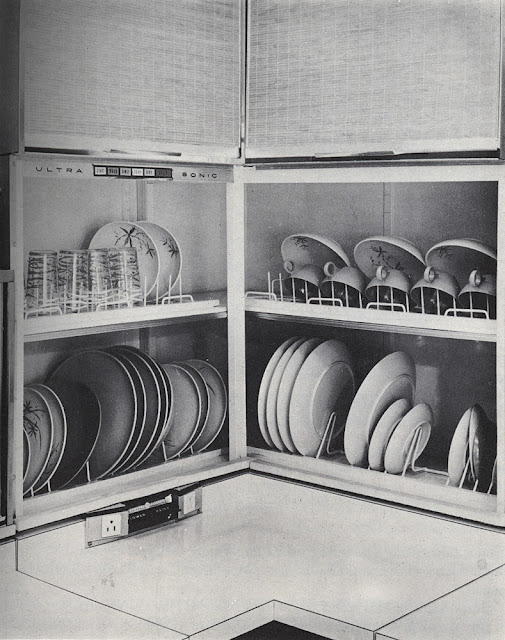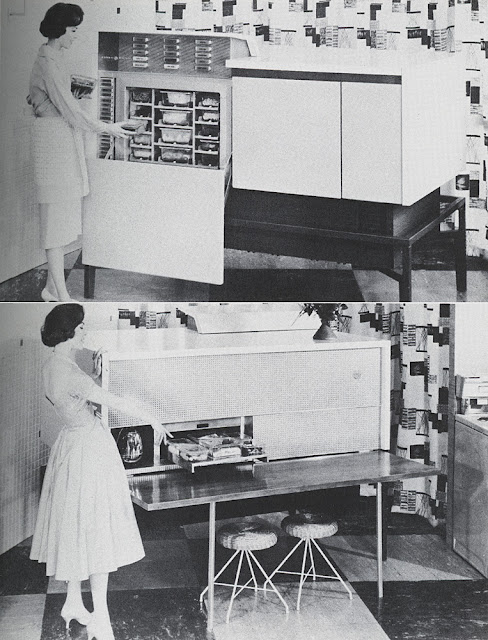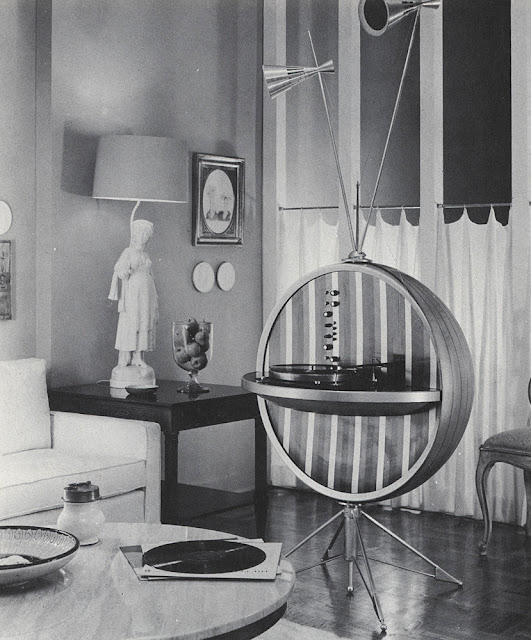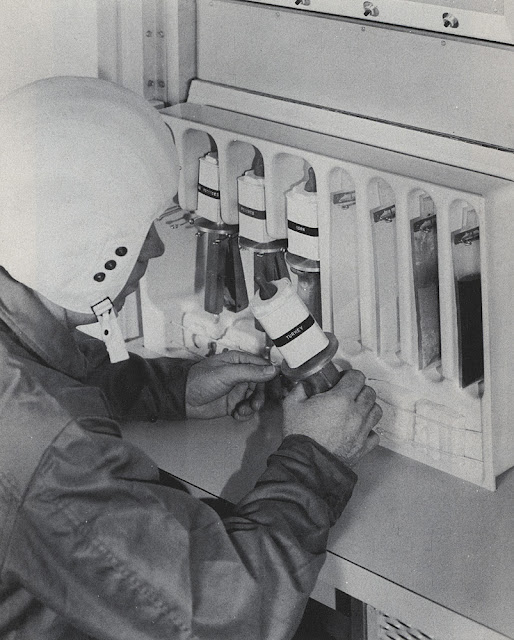Toasted bacon wrapped in tin trays, sonic dishwashers and fridges that appear from under the kitchen floor – this was how life was supposed to be 40 years ago.
These pictures are from a 1962 book called 1975: And the Changes to Come by Arnold B. Barach. They predict what the world of the future looked like from the early 60s – and many of them turned out to be surprisingly accurate, though they didn’t necessarily come about by 1975.
1. Translating Machine.
Typist copies story from Russian newspaper Pravda on special machine which converts Russian letters to punched holes in paper tape. Insertion of the tape into another machine produces translation. By the 1970’s, automatic translation of practically all foreign publications and books will be routine.
2. Reference Finder.
Every 60 seconds, day and night, approximately 2,000 pages of books, newspapers, or reports are published somewhere in the world; and the output is increasing by leaps and bounds. Libraries will ultimately be forced to use computers such as this for locating documents and references, since it will be so difficult otherwise to keep up with the printed material. This pioneering installation is at the Center for Documentation and Communication Research at Western Reserve University.
3. Reading Machine.
Printed pages or typewritten documents placed in this machine are recorded on punched paper at a speed of 240 characters a second. The punched paper then can be fed into another unit for reproduction of what the machine “read.” A few offices are already being supplied with this type of machinery. By 1975, it will be standard office equipment.
4. Push-Button Learning.

5. Teacher’s Helper.
In this classroom, the lesson and questions-in spelling, history, geography, and other subjects-are on a series of stacked cards at the top of the device. The student answers the questions by pushing one of four buttons. If he pushes the right one, the page drops down, revealing the next step in the lesson. The machine also scores each student,. thus spots the slow learners for the teacher.
6. Film Based Teaching Machine.
Student pushes one of four buttons to give answers and his score appears on paper slip at upper right. Teaching machines, expected to boom in the next decade, usually operate on the principle of repetition until the pupil understands. They aim to speed up the learning process and relieve teacher of much paper work in the classroom.
7. Kitchen for a 1975 Bride.
The dishwasher is ultrasonic. The freezer and refrigerator units (rear) are lowered and raised at the push of a button, disappearing behind the plastic paneling when not in use. The range is electronic. Special cabinets are included for storing atomicradiated foods. Most manufacturers of electrical equipment have designed similar kitchens for the seventies. This one is the brain child of Kelvinator.
8. Wash Dishes Ultrasonically.
High frequency sound waves energize the water to wash the dishes in this ultrasonic dishwasher. A device called a transducer produces the high frequency sound waves (about 20,000 cycles per minute), pitched so high they cannot be heard by the human ear. Ultrasonic washers are more effective than existing types; they scour without scratching, remove baked-on matter readily, and wash much faster than any type now in general use. The same principle of ultrasonic cleaning will be applied to washing machines within another decade.
9. Push a Button, Get a Meal.
Among tomorrow’s “wife-savers” is this working model of a combination electronic oven and food freezer. Meals are prepared in advance and stored in the individual freezer compartments, each one labeled on the corresponding push buttons. At dinner time, the housewife pushes the appropriate buttons; and in less than half an hour, the full meal emerges at the rear end of the appliance, hot and ready to serve (lower picture).
10. Oven in the Round.
Portable oven, by designer Greta Magnusson Grossman, is intended for broiling and baking at the table, on the patio, or in the kitchen. Round half-spheres can be moved in either direction to open or close the oven. Cooking would be by fast radiant heat. Devices such as this point the way to new informality in the home.
11. Bacon in a Toaster.
Bacon would be prefried, then hermetically sealed in this design for a future aluminum package. One way to heat it for eating would be to drop it in the toaster; another, put in oven or broiler. A major advantage is the elimination of utensils for cooking. Package is opened by turning back the edges. Leftovers are easily preserved by refolding the pouch.
12. Two Variations of Future Television Sets.
On the left, a triple-purpose unit for the housewife, enabling her to watch her children at play or identify visitors at the door or watch her favorite color television program. On the right, a salesman’s video-audio tape player, housed in an attaché case, and designed to project visual sales presentations as well as to function as a dictation unit.
13. What’s On Delhi-Television Tonight?
This is the ultimate in proposed television sets for a decade hence. It can receive television signals bounced from circling satellites, bringing programs from any city on the globe. The spot of origin of the program is indicated by a light on the world map in the upper panels. Round dials are clocks showing the hour in four major time zones. Dials at right are for tuning and sound control. The set is only three inches thick. On the reverse side it is equipped with an international stereophonic radio.
14. Hi-Fi Sphere.
High-fidelity sets do not have to be square, and they do not have to be long. This look into tomorrow is an effort to blend the feeling of a musical instrument with modern electronics. Engineers have long maintained that a sphere is the ideal source of sound reproduction. Note these features: The cone speakers are retract-lc, can have a span of six feet between them, and can be pitched in any direction the best stereophonic effect. In the base of the sphere is a woofer speaker, facing inward. When not in use, the three-foot aluminum globe can be completely closed present a decorative sphere.
15. House for a Small City Lot.
Lightweight steel arches are the secret of this low-cost house for a city lot of limited area. Note how arches span both living area and outdoor recreational area. Model with roof removed shows how living space would be arranged. By 1975, land to build on will be much scarcer than today in big-city areas, so architects experiment with new housing concepts such as this to make the most of what will be available.
16. Fun for the Family.
Designers prepare for the future with new recreational concepts for the family. This beach house has multicolored aluminum roof and glass walls, offering complete access to the out-of-doors. Peaked roof is 15.5 feet above the floor, and walls radiate from central column like spokes on a wheel.
17. Heart Alarm.
Heart victims’ lives might be saved with these electronic devices, demonstrated by inventor Morris Tischler. The “Cardiac Pacer” is worn by heart patients and automatically emits electrical stimulants in the event the heart falters. The “Cardiac Monitor” keeps track of the heart rate, and, in the event of trouble, activates the Pacer, sets off a high-pitched alarm, and broadcasts a special signal to a receiver carried by the doctor. The signal broadcasts for a distance of two and a half miles. Unit is for bedside use, either at home or in a hospital, and is likely to be standard equipment of heart specialists in another few years.
18. Lunch at Zero Gravity.
Snack bar for future astronauts is well along in development. Spacemen will be able to eat almost anything, but it will take an expelling device such as this to force food from container to the diner; at zero gravity knives and forks are useless, since they-and any food on a plate-would float around the rocket ship’s cabin. Expelling device screws onto punctured can and is operated by squeezing to force food through the nipple. Research is going on at the Aeromedical Laboratory at Wright-Patterson Air Force Base.
19. Operating Heart of a Reactor.
Graphite in each of the 119 “cans” in this cylindrical tank controls the neutrons that produce atomic fission. Fuel elements are slid into the coiled springs. This is the core of an experimental sodium reactor which is expected to demonstrate a more economical way of producing electricity from atomic energy than is possible with existing reactor designs.
20. How to Preserve Foods.
A rack of canned beans is lowered into a radioactive container where, in six to twenty minutes, the beans will receive enough radiation to preserve them indefinitely. Atomic radiation of foods will be routine in the seventies. Meats, vegetables, and fruits will be preserved by the process. Radiated foods can be kept for years with little or no refrigeration.
21. Atomic Power for Space.
Atomic reactor is one of the “Kiwi” experimental designs, predecessor of atomic units that will be used to send rockets millions of miles through space.
(from 1975: And the Changes To Come by Arnold B. Barach, via Derrick Bostrom’s Flickr)



